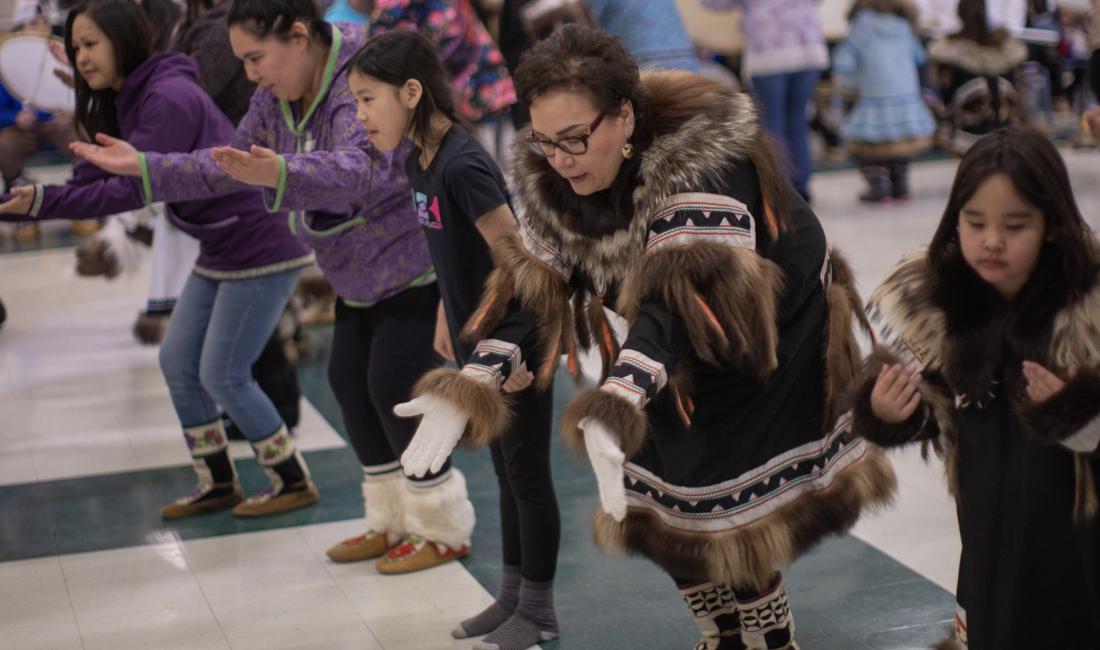
Drum Dancing
Inuvialuit Regional Corporation is excited to announce that our Cultural Resource Centre shares music available for streaming on the following online platforms:
Our goal is to make language learning more accessible to all beneficiaries and anyone interested in listening to and learning traditional Inuvialuit songs and dances.
From early times, Inuvialuit have used songs and dancing to recount legends, stories, and traditions. Accompanied by the rhythmic beat of drums, dancers use motions that act out the words of the songs – usually reenactments of great feats accomplished by previous generations. During celebrations, the blend of the drum beat and the rhythmical rise and fall of voices, punctuated with shouts of “auu yah iah!“, quickly drew men and women to the dance floor.
Drum dancing is performed to the rhythmic beating of caribou skin drums. To achieve the right tautness, drums are made from the stomach skin of young caribou taken in the summer. Finished drums are approximately 24 inches in diameter, stretched across wooden frames.
Songs usually start softly with drummers tapping their drums and dancers swaying rhythmically. As the song continues, drums are struck harder and the people sing louder. Dancers throw their bodies into the song with arms and knees bent, their outstretched, open hands wave to and fro capturing the drum beat.
Here are some examples of traditional drum dance songs and the legends, stories, and traditions they tell:
Years ago Inuvialuit did not travel with outboard motors. When the current became too strong they used ropes to pull their boats along the river. The ropes would often get caught on the willows. The traveller would be forced to pull a little harder to get the ropes untangled.
A group of people run low on food in their camp. One morning, a man makes a seal net and starts walking out onto the ice to look for a place to set it. After walking for a while, he decides on a good place. He chisels out a hole in the ice and after taking out the slush, sets the net. Later, he checks the net by pulling it out and finds that he has caught a seal. He pulls out the seal and puts his hands up in the air to say how happy everyone will be when he invites them over to have some fresh meat. He turns and pulls the seal home.
A man prepares to go caribou hunting. Instead of taking his harpoon, he takes his muzzle-loader gun. He walks most of the day until he finally spots some caribou. Kneeling down, he sneaks up on them. When he gets close, he readies his gun, taking careful aim. When he pulls the trigger the gun misfires. He tries to fix the weapon, but does not know how. Disappointed, he gives up and starts walking home. He thinks about smashing the gun and wrapping the barrel around the first stump he comes to.
A man goes out to cut some wood. He walks to a tree and kicks it to get the snow off the branches. Then he chops down the tree and drags it away. Finally, he saws the tree into blocks and piles them up.
Many dances came from watching animals doing everyday things. Years ago, one elder watched some ducks on a lake picking at their tail feathers and then taking off from the lake.
A man wakes up one morning to find there is no fire in the stove. He complains it is too cold. Then he realizes that he has to get out of bed to make a fire, cook and go out to hunt for more food.
This song is usually performed at the end. It is an invitation dance to get people up onto the dance floor to have a good time, an experience that should not be avoided and an opportunity that should not be ignored!
Thank you and happy listening!